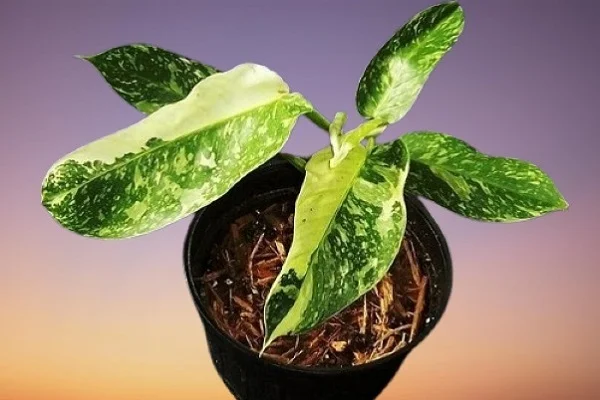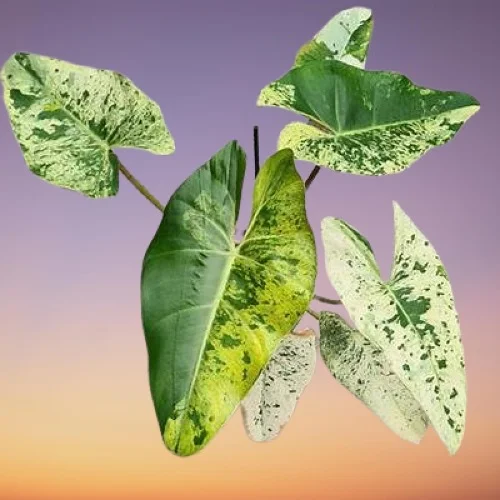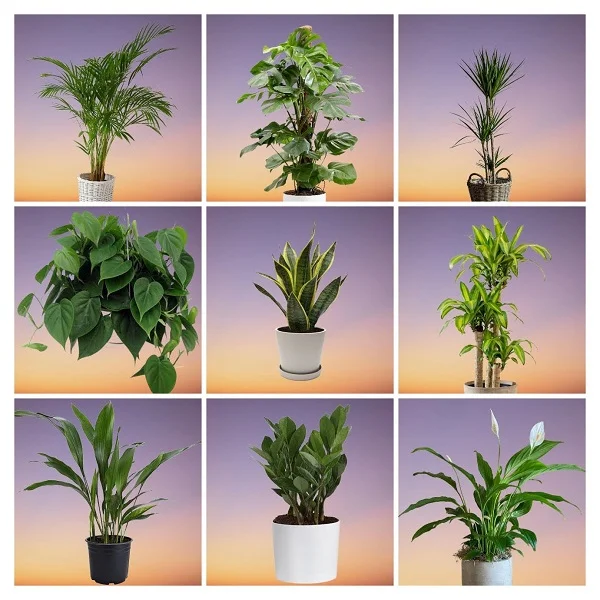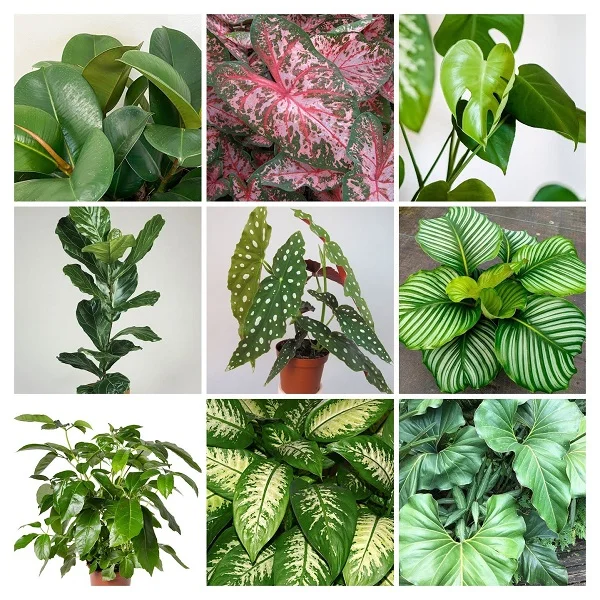Philodendron ilsemanii Variegata Care Indoors, Propagation and Growing Problems
Some links in this post may be affiliate links
Philodendron ilsemanii Variegata grows best in bright indirect light, warm and humid conditions and moderately moist, rich, well-drained, all purpose soils coupled with monthly feeding in the growing season.
Philodendron ilsemanii Variegata also called Mottled Ilsemanii is among the rare, evergreen, climbing Philodendron varieties and bears large, slender, pointed leaves with green and white variegation which emerge in deep-green and develop the variegation as they continue to grow. The variegation varies from leaf to leaf.
Philodendron ilsemanii Variegata like Spadeleaf Philodendron (Philodendron domesticum), Finger-leaf Philodendron (Philodendron elegans), Blushing Philodendron (Philodendron erubescens) and Silver Sword Philodendron (Philodendron hastatum) can be grown as a climber on a trellis or moss pole where it can beautifully display its variegated leaves. Firm support needs to be provided for the stems to prevent the plant from toppling over.
On account of its growth habits and spectacular foliage, Mottled Ilsemanii is one of the best plants for the office space where it will create a delightful first impression as well as be a great conversation starter.

Botanical name: Philodendron ilsemanii 'Variegata'
Family: Araceae
Common name: Mottled Ilsemanii
Origin
Philodendron ilsemanii Variegata origin is not known. It is thought to be a cultivar of Philodendron corcovadense though there is no available documentation to confirm this.
Toxicity
According to National Capital Poison Center, Philodendron ilsemanii Variegata like other Philodendrons are toxic to both humans and pets. The plants contain Calcium oxalate crystals. If ingested, these crystals can cause burning and swelling in the mouth and throat, vomiting, diarrhea and abdominal pains. Therefore, keep the plant away from the reach of children and pets.
Where to buy
If you would like to acquire Mottled Ilsemanii, you may obtain these plant online from Etsy (Link to Etsy).
Philodendron ilsemanii Variegata Care Indoors
Philodendron ilsemanii Variegata (Mottled Ilsemanii) prefers bright indirect light (filtered light), average warmth of 20-280C, humidity of 60-70% and moderately moist, fertile, well-drained, all purpose soils coupled with regular feeding during the growing season.
Philodendron ilsemanii Variegata requires regular pruning to keep the plant neat, encourage a bushy growth and rejuvenate growth. Repotting of the young plant is needed when it becomes pot-bound while the large plants require annual replenishment of the soil. Keep reading for a detailed account on these conditions and how to achieve them.

Watering
Water Philodendron ilsemanii Variegata liberally during the growing season while allowing the top 2-3 inches of soil to dry out between waterings to keep the soil moderately moist.
Decrease watering during the cold season as growth is minimal at this time to keep the soil slightly moist. Use water that is at room temperature to avoid shocking this tropical plant.
Ascertain that the pot has a drainage hole to prevent the soil from getting soggy as it can lead to root-rot and death of the plant.
Light Requirements
Philodendron ilsemanii Variegata thrives in bright indirect light. Keep it away from direct sunlight as it can scorch the leaves.
Inadequate light will result in leggy growth, small-sized pale leaves and loss of variegation. Therefore, if the natural light is too low, consider investing in grow lights to supplement it.
Rotate the pot regularly to ensure that the plant receives light on all sides for even growth as well as prevent legginess.
Temperature and Humidity
Philodendron ilsemanii Variegata prefers average warmth within the range of 20-280C. Keep it away from drafts to prevent extreme temperatures. Too high temperatures may cause yellowing and leaf drop while too low temperatures can result in reduced growth, even death of the plant.
Mottled Ilsemanii requires a humidity of 60-70% to thrive. Low humidity for prolonged periods can result in curled leaves and brown leaf tips and edges. To raise humidity, set the pot on a wet pebble tray or use a cool mist humidifier. Learn more on how to elevate humidity for houseplants.
Clean the leaves regularly by damp-wiping with a soft cloth to get rid of dust and to discourage pest infestation. Maintain proper ventilation to minimize fungal diseases.
Fertilizer
Feed Philodendron ilsemanii Variegata every 3-4 weeks during the growing season with a balanced, water-soluble fertilizer for lush growth. Stop feeding in the cold season as growth is minimal at this time and feeding at this time can lead to fertilizer burn and death of the plant.
Potting Mix
The best potting mix for Philodendron ilsemanii Variegata should be rich in organic matter and free-draining to prevent it from getting soggy while providing the required nutrients. All purpose potting soils are ideal for the plant.
Repotting
Repot young Philodendron ilsemanii Variegata at the beginning of the growing season. Use a pot that is 1-2 sizes larger and loose, free-draining soil that is rich in organic matter. Make sure that the pot has a drainage hole to prevent the soil from getting soggy as it can lead to root-rot. Check out these pots with drainage holes on Amazon.
The large Mottled Ilsemanii may be impossible to repot due to their enormous size. Therefore, replenish the top 2-3 inches of soil at the beginning of the growing season or as necessary. Take care not to injure the roots to avoid fungal infestations.
Pruning
Pruning Philodendron ilsemanii Variegata involves removal of yellow and dead leaves to maintain the plant neat and also discourage pests and diseases.
To encourage a bushy and compact growth, pinch off the growing tips at a point above the node as new growth emerges from a node. The tips can be used to propagate new plants. Cutback the leggy stems to the soil level at the beginning of the growing season to rejuvenate growth. Learn more on how to prune houseplants.
Propagation
Philodendron ilsemanii Variegata (Mottled Ilsemanii) propagation can be done during the growing season from stem cuttings. The stem cuttings can be rooted in soil or in water.
How to propagate Philodendron ilsemanii Variegata from stem cuttings in soil
Take a stem cutting of about 4-5 inches long from a healthy Philodendron ilsemanii Variegata by cutting the stem below a leaf node. Strip off the lower leaves.
Insert the cutting in moist, well-drained soil while ensuring that at least one leaf node is below the soil.
Place the set up in a warm, well-lit place and maintain the soil moist until new growth emerges.
Allow the new Mottled Ilsemanii to be well established before transplanting after which you can begin routine care.
How to propagate Philodendron ilsemanii Variegata from stem cuttings in water
Take a stem cutting of about 4-5 inches long from a healthy Philodendron ilsemanii Variegata by cutting the stem below a leaf node. Strip off the lower leaves.
Place the cutting in a jar of clean water while ensuring at least one leaf node is below the water surface.
Position the set up in a well-lit place and change the water every 5-7 days until roots have developed.
Transfer the new plants into individual pots in moist, free-draining soil when the roots are about 4 inches long.
Maintain the soil moist until new growth has emerged on the cuttings.
Allow the new plants to be well established before transfering the pots to their permanent position after which you can begin routine.

Philodendron ilsemanii Variegata Problems
The main problems in Philodendron ilsemanii Variegata include loss of variegation, yellow leaves, dropping leaves, brown leaf tips and edges, rotting, pests and diseases among others. Keep reading for more on these problems and how to fix them.
Rotting stems
Rotting stems in Philodendron ilsemanii Variegata are an indication of stem-rot disease which is promoted by high moisture and too little warmth. To save the plant, repot it in fresh dry soil and keep the soil dry and warm for a period of time before watering. Read more on how to treat stem-rot disease in houseplants.
Diseases
Philodendron ilsemanii Variegata is prone to powdery mildew and leaf spot disease which are enhanced by overwet conditions coupled with poor air circulation. Isolate the affected plant to prevent spread to the rest of the plants and spray it with a fungicidal solution. Ensure to cover the entire plant; the leaves and the stems.
To prevent future infestation, avoid wetting the foliage and water from the bottom instead. Also ensure that there is good air circulation for the plant.
Pests
The common pests in Philodendron ilsemanii Variegata are aphids, scales and mealybugs. Isolate the affected plant to prevent spread to other plants and treat it with neem oil or insecticidal soap as indicated by the manufacturer.
Leggy growth and small pale leaves
Too little light is the cause of leggy growth and small pale leaves as Philodendron ilsemanii Variegata will not grow in shade. Position it in a more brighter spot where it will receive bright indirect light or instal a grow light where natural light is insufficient. Have a look at this guide on understanding light for houseplants.
Loss of variegation
Loss of variegation in Philodendron ilsemanii Variegata is due to too little light. Move the plant to a more brighter spot where it will receive bright indirect light or instal a grow light where the natural light is not enough.
Yellow leaves
If many leaves are affected and there are signs of wilting and rotting, overwatering Philodendron ilsemanii Variegata is the reason for yellow leaves. Water the plant thoroughly during the growing season while allowing the top 2-3 inches of soil to dry out between waterings.
Reduce the amount and frequency of watering in the cold season to maintain the soil slightly moist. To avoid getting soggy soil, ensure that the pot has a drainage hole and that the soil is free-draining. Read more on how to water indoor plants correctly.
If there is no wilting and rotting, underfeeding is the cause of yellow leaves Feed the plant every 3-4 weeks during the growing season with a balanced water-soluble fertilizer and withhold feeding during the cold season to avoid fertilizer burn. Learn how to feed houseplants.
If only lower leaves are affected and have dark spots and new leaves are dark and small, then underwatering is the cause of the yellow leaves. To remedy the problem, water the plant liberally during the growing season while allowing the top 2-3 inches of soil to dry out between waterings but never allow the soil to dry out completely.
If leaves are pale colored and have straw-colored patches the cause of yellow leaves is exposure to direct sunlight. Shield the plant or keep it away from direct sunlight.
Dropping leaves
The lower leaves in Philodendron ilsemanii Variegata will drop as they age but if there is an abnormal leaf drop, the reason is sudden change of the growing conditions. Avoid moving the plant to a new position before acclimating it.
If the leaves turn brown and dry before they drop, then too high temperature is the cause of leaf drop. Mottled Ilsemanii prefers average warmth of 20-280C. Protect it from hot drafts; keep it away from hot air vents or near any heat source. Check out this guide on understanding temperature for houseplants.
Brown leaf tips and edges
There are two possible causes of brown leaf tips and edges in Philodendron ilsemanii Variegata. One possible cause of brown leaf tips and edges is dry air (low air humidity). Set the pot on a wet pebble tray or use a cool mist humidifier to raise humidity for the plant.
The second possible cause of brown leaf tips and edges in Mottled Ilsemanii is that the plant is root-bound. Repot the plant into a pot 1-2 sizes larger. Ensure the pot has a drainage hole to prevent the soil from getting soggy.
You liked it? Share on social media.
Realted Content
Amazon Associates Disclosure
Homeplantsguide.com is a participant in the Amazon Services LLC Associates Program, an affiliate advertising program designed to provide a means for sites to earn advertising fees by advertising and linking to amazon.com.





